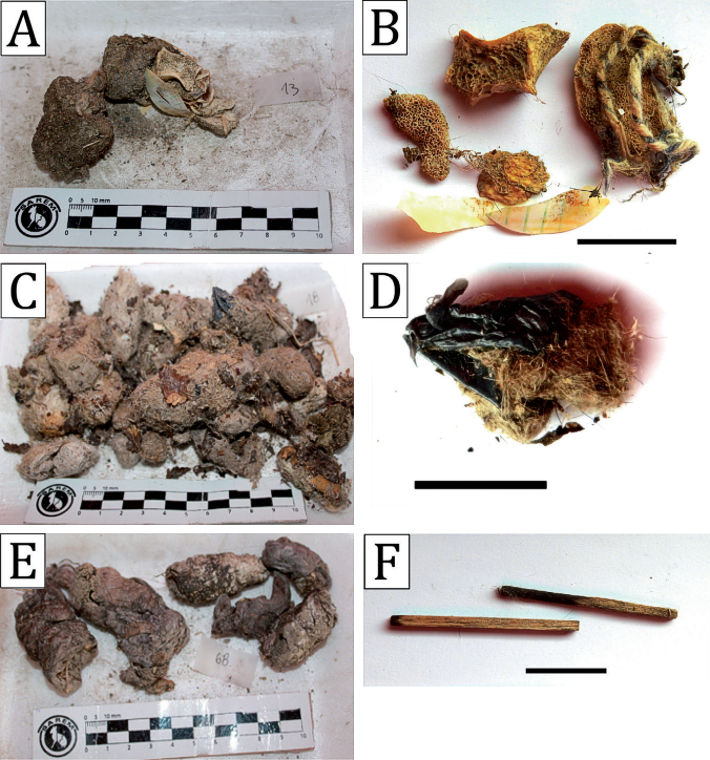Primer registro de basura en heces de puma (Puma concolor) en el Parque Nacional Los Glaciares, provincia de Santa Cruz, República Argentina
DOI:
https://doi.org/10.31687/saremNMS.20.0.29Abstract
In this work we report the finding of waste remains in puma feces in Los Glaciares National Park (LGNP), Santa Cruz province (Argentina). The residues were found in three puma feces collected on the trekking trails within the Park, and included the following items: thread, matches, and two types of polyethylene. We recommend continuing with the analysis of puma feces, while incorporating samples from other carnivore species present in the park. This information will allow discerning whether animals are changing their feeding habits or if events like these are part of accidental consumption.
References
Acosta Jamett, G., W. Chalmers, A. Cunningham, S. Clevelands, I. Handel, & B. Bronsvoort. 2011. Urban domestic dog populations as a source of canine distemper virus for wild carnivores in the Coquimbo region of Chile. Veterinary Microbiology 152:247–257.
Bartolucci, C. 2019. Hábitos alimenticios del puma, Puma concolor (Linnaeus, 1771) (Felidae, Carnivora), en la zona norte del Parque Nacional Los Glaciares, provincia de Santa Cruz, República Argentina. Tesis de grado. Universidad Nacional de la Patagonia San Juan Bosco, Esquel, Argentina.
Bateman, P., & P. Fleming. 2012. Big city life: carnivores in urban environments. Journal of Zoology 287:1–23.
Beckmann, J., & J. Berger. 2003. Rapid ecological and behavioural changes in carnivores: the responses of black bears (Ursus americanus) to altered food. Journal of Zoology 261:207–212.
Beltrán Ortiz, E., H. Cadena Ortiz, & J. Brito. 2017. Dieta del zorro de páramo Lycalopex culpaeus (Molina 1782) en un bosque seco interandino del norte de Ecuador. Mastozoología Neotropical 24:437–441.
Birochio, D. 2008. Ecología trófica de Lycalopex gymnocercus en la región pampeana: un acercamiento inferencial al uso de los recursos. Tesis doctoral. Universidad Nacional del Sur, Bahía Blanca, Argentina.
Cáceres Martínez, C., A. Acevedo Rincón, & L. Sánchez Montaño. 2015. Registros de plásticos en la ingesta de Tremarctos ornatus (Carnivora: Ursidae) y de Nasuella olivacea (Carnivora: Procyonidae) en el Parque Nacional Natural Tamá, Colombia. Revista Mexicana de Biodiversidad 86:839–842.
Chame, M. 2003. Terrestrial mammal feces: a morphometric summary and description. Memorias do Instituto Oswaldo Cruz 98:71–94.
Fernández, C., & R. Baldi. 2014. Hábitos alimentarios del puma (Puma concolor) e incidencia de la depredación en la mortandad de guanacos (Lama guanicoe) en el noreste de la Patagonia. Mastozoología Neotropical 21:331–338.
Fischer, J. R., & R. Gerhold. 2002. La fauna silvestre como factor de riesgo para la salud animal y las zoonosis. Organización Mundial de Sanidad Animal 281–289.
García, C., N. Sandoval, A. Silva, J. Godoy-Güinao, & I. Díaz. 2018. Consumo de residuos y desechos de origen antrópico por zorros (Lycalopex sp.) en la Reserva Nacional Río Clarillo, Región Metropolitana, Chile. Biodiversidata 6:27–32.
Gunther, K., M. Haroldson, K. Frey, S. Cain, J. Copeland, & C. Schwartz. 2004. Grizzly bear–human conflicts in the Greater Yellowstone Ecosystem, 1992–2000. Ursus 10:22–23.
Home, C., R. Pal, R. Sharma, R. Suryawanshi, K. Bhatnagar, & A. Vanak. 2017. Commensal in conflict: livestock depredation patterns by free-ranging domestic dogs in the Upper Spiti landscape, Himachal. Ambio 46:655–666.
Honacki, J., K. Kinman, & J. Koepp. 1982. Mammal species of the world. A taxonomic and geographic reference. Allen Press, Inc. and the Association of Systematics Collections, Lawrence, Kansas.
Iriarte, J., W. Franklin, W. Johnson, & K. Redford. 1990. Biogeographic variation of food habits and body size of the American puma. Oecologia 85:185–190.
Jankowiak, Ł., A. Malecha, & A. Krawczyk. 2016. Garbage in the diet of carnivores in an agricultural area. European Journal of Ecology 2:1–6.
Katlam, G., S. Prasad, M. Aggarwal, & R. Kumar. 2018. Trash on the menu: patterns of animal visitation and foraging behaviour at garbage dumps. Current Science 12:2322–2326.
Logan, K., & L. Sweanor. 2010. Behavior and social organization of a solitary carnivore. Cougar: ecology and conservation (M. Hornocker & S. Negri, eds.). University of Chicago Press, Chicago.
Martina, A., & M. Gallaratti. 1997. Use of a garbage dump by some mammal species in the Majella Massif (Abruzzo, Italy). Hystrix 9:23–29.
Montanelli, S. 2001. Notas sobre ecología alimentaria, densidad relativa e impacto turístico en los carnívoros del Parque Nacional Iguazú, Misiones, Argentina. Tesis doctoral. Universidad de Buenos Aires. Buenos Aires, Argentina.
Nowell, K., & P. Jackson. 1996. Wild cats: status survey and conservation action plan. IUCN/SSC Cat Specialist Group. IUCN, Gland.
Peirce, K., & D. Van. 2006. Use of a garbage dump by brown bears in Dillingham, Alaska. Ursus 17:165–177.
Plaza, P., & S. Lambertucci. 2017. How are garbage dumps impacting vertebrate demography, health, and conservation? Global Ecology and Conservation 12:9–20.
Quiroga, V. 1997. Hábitos alimentarios del zorro gris (Pseudalopex griseus) en el NE del Chubut. Tesis de grado. Universidad Nacional de la Patagonia San Juan Bosco, Puerto Madryn, Argentina.
Reshamwala, H., S. Shrotriya, B. Bora, S. Lyngdoh, R. Dirzo, & B. Habib. 2017. Anthropogenic food subsidies change the pattern of red fox diet and occurrence across Trans-Himalayas, India. Journal of Arid Environments 150:15–20.
Zanón Martínez, J., A. Travaini, S. Zapata, D. Procopio, & M. Santillan. 2012. The ecological role of native and introduced species in the diet of the puma (Puma concolor) in southern Patagonia. Oryx 46:106–111.

Downloads
Published
How to Cite
Issue
Section
License
Copyright (c) 2020 Cristina S. Bartolucci, María de las Mercedes Guerisoli, Gabriel M. Martin

This work is licensed under a Creative Commons Attribution-NonCommercial 4.0 International License.

